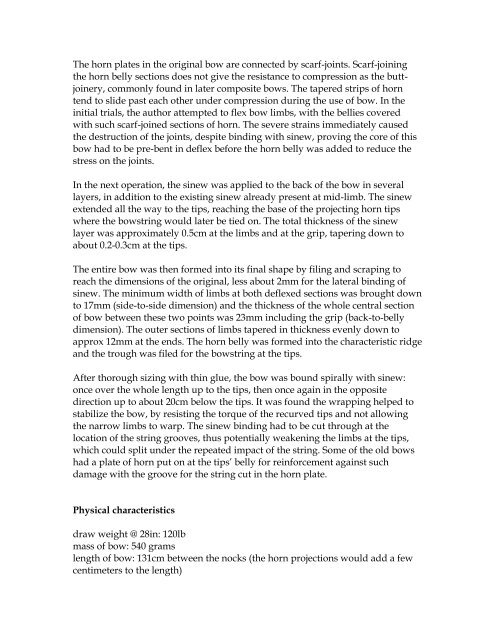Create successful ePaper yourself
Turn your PDF publications into a flip-book with our unique Google optimized e-Paper software.
The horn plates in the original bow are connected by scarf-joints. Scarf-joining<br />
the horn belly sections does not give the resistance to compression as the buttjoinery,<br />
commonly found in later composite bows. The tapered strips of horn<br />
tend to slide past each other under compression during the use of bow. In the<br />
initial trials, the author attempted to flex bow limbs, with the bellies covered<br />
with such scarf-joined sections of horn. The severe strains immediately caused<br />
the destruction of the joints, despite binding with sinew, proving the core of this<br />
bow had to be pre-bent in deflex before the horn belly was added to reduce the<br />
stress on the joints.<br />
In the next operation, the sinew was applied to the back of the bow in several<br />
layers, in addition to the existing sinew already present at mid-limb. The sinew<br />
extended all the way to the tips, reaching the base of the projecting horn tips<br />
where the bowstring would later be tied on. The total thickness of the sinew<br />
layer was approximately 0.5cm at the limbs and at the grip, tapering down to<br />
about 0.2-0.3cm at the tips.<br />
The entire bow was then formed into its final shape by filing and scraping to<br />
reach the dimensions of the original, less about 2mm for the lateral binding of<br />
sinew. The minimum width of limbs at both deflexed sections was brought down<br />
to 17mm (side-to-side dimension) and the thickness of the whole central section<br />
of bow between these two points was 23mm including the grip (back-to-belly<br />
dimension). The outer sections of limbs tapered in thickness evenly down to<br />
approx 12mm at the ends. The horn belly was formed into the characteristic ridge<br />
and the trough was filed for the bowstring at the tips.<br />
After thorough sizing with thin glue, the bow was bound spirally with sinew:<br />
once over the whole length up to the tips, then once again in the opposite<br />
direction up to about 20cm below the tips. It was found the wrapping helped to<br />
stabilize the bow, by resisting the torque of the recurved tips and not allowing<br />
the narrow limbs to warp. The sinew binding had to be cut through at the<br />
location of the string grooves, thus potentially weakening the limbs at the tips,<br />
which could split under the repeated impact of the string. Some of the old bows<br />
had a plate of horn put on at the tips‟ belly for reinforcement against such<br />
damage with the groove for the string cut in the horn plate.<br />
Physical characteristics<br />
draw weight @ 28in: 120lb<br />
mass of bow: 540 grams<br />
length of bow: 131cm between the nocks (the horn projections would add a few<br />
centimeters to the length)


